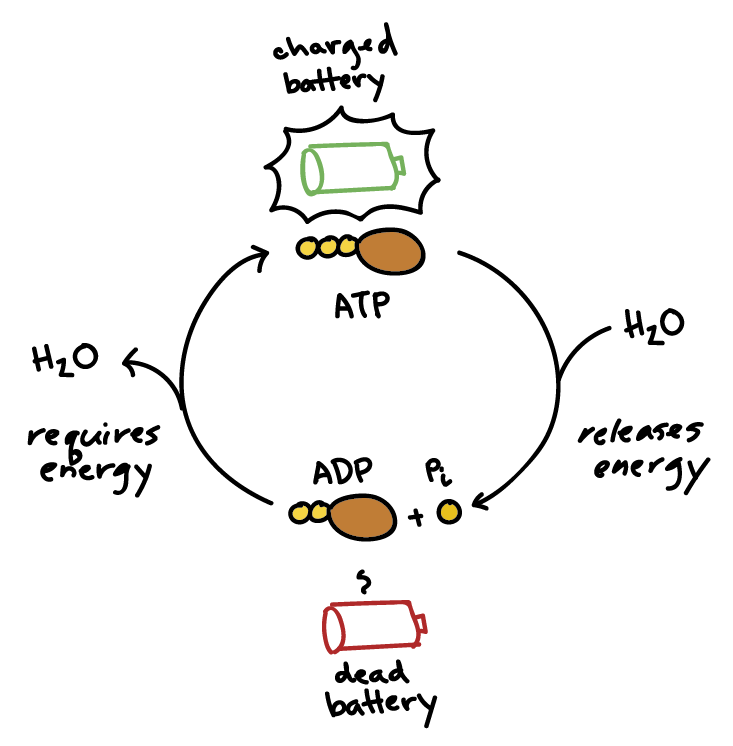What Describes the Conversion of Adp to Atp
This reaction is commonly referred to as the hydrolysis of ATP. Conversion from ATP to ADP Adenosine triphosphate ATP is the energy currency of life and it provides that energy for most biological processes by being converted to ADP adenosine diphosphate.

Difference Between Atp And Adp Compare The Difference Between Similar Terms
Skulls of 1 modern gorilla 2 australopithecus afarensis 3 homo erectus 4 homo neanderthalensis 5 homo sapiens based on the diagram which of the following best describes ways in which the physical appearance.

. ATP is the main energy currency of the cell and is needed to power many energy-requiring cellular reactions. Release of energy as one phosphate group detaches. ATP is Adenosine Triphosphate and ADP is Adenosine Diphosphate.
The phosphorylation of adp to ATP linked to the oxidation of metabolic fuels With the exception of glycolysis which is a cytosolic pathway most of the reactions in the oxidation of metabolic fuels occur inside the mitochondria and lead to the reduction of nicotinamide nucleotide and flavin coenzymes. What describes the conversion of adp to atp. Animals use the energy released in the breakdown of glucose and other molecules to convert ADP to ATP which can then be used to fuel necessary growth and cell maintenance.
What must be true about this hydrolysis. Greater ATP production will positively regulate GTP synthesis because ATP is involved in the conversion of xanthosine-5-monophosphate into guanosine-5-monophosphate. ADP gets converted into ATP in presence of inorganic phosphate and energy irrespective of whether the energy is obtained.
The energy released by hydrolysis breakdown of ATP is used to power many energy-requiring cellular reactions. ATP and ADP are considered as currency of energy. An input of energy as both phosphate groups detach.
What describes the process of conversion of ADP to ATP. The diagram shows the structure of adenosine diphosphate ADPWhat describes the process of conversion of ADP to ATP. Which of the following statements correctly describes an interaction between the ATP and GTP biosynthetic pathways.
ISSA Converting ATP into energy By Hristina Rangelova Describe the process of converting adenosine triphosphate ATP into energy within the human body. It is the addition of a phosphate group to ADP to form. Adenosine triphosphate a nucleotide adenosine 5-triphosphate.
Bio Test 4 DRAFT. The hydrolysis of phosphoenolpyruvate to pyruvate drives the conversion of ADP to ATP. ADP and ATP are inter-convertible.
What describes the conversion of ADP to ATP. Bio Test 4 DRAFT. The lower energy Adenosine DiPhosphate ADP is then re-energized during photosynthesis as the phosphate group is re-attached thus completing the cycle of ATP to ADP to ATP.
2 Show answers Another question on Biology. The conversion takes place in the substance between the cell membrane and the nucleus known as the cytoplasm or in special. It can be thought of as the main energy currency of cells much as money is the main economic currency of human societies.
ATP is consumed by different metabolic processes converting it to adenosine diphosphate ADP or adenosine monophosphate AMP. The main structural difference between ATP and ADP is that ATP consists of three phosphate molecules whereas ADP molecule consists. Adenosine triphosphate is the cellular energy molecule and is found in the cells of all living things.
It is the process by which light energy is captured to form simple sugars using water and carbon dioxide and to release oxygen gas as a byproduct. The conversion occurs in the cytoplasm which lies between the cell membrane and the nucleus or in. The endergonic conversion of ADP to ATP requires more than 30 kJmol.
Hydrogen ions down a concentration gradient. What describes the conversion of ADP to ATP. Plants use photosynthetic pathways to convert and store energy from sunlight also conversion of ADP to ATP.
Right click the image below to download the worksheet. Since the basic reaction involves a water molecule ATP H 2 O ADP P i. An input of energy to attach a third phosphate group Stuart is listing the changes to matter and energy that occur during the process of.
Would the formation of ATP molecules from glucose oxidation be an example of energy transformation or conversion. ADP is converted to ATP for the storing of energy by the addition of a high-energy phosphate group. The hydrolysis reaction is more endergonic than the conversion of ADP is exergonic.
Describe what takes place in the process of converting ADP to ATP. A high-energy phosphate group is added to ADP to make ATP for energy storage. Adenosine triphosphate or ATP is a small relatively simple molecule.
The conversion of ADP in to ATP requires molecules of hexose sugar to break down. A release of energy as a third phosphate group is attached. ATP structure and hydrolysis.
Below is an image of a worksheet I use in my Biology classes to help students learn the ATP Cycle to mastery. An input of energy to attach a third phosphate group. Both ATP and ADP are composed of a ribose sugar adenosine and phosphate molecule.
ATP is formed by conversion of ADP in presence of inorganic phosphate and energy.


No comments for "What Describes the Conversion of Adp to Atp"
Post a Comment